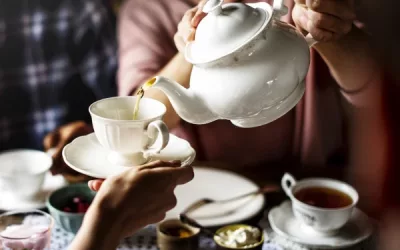Have you ever thought about how afternoon tea can adapt to modern dietary choices? Vegan afternoon tea is not just a trend; it’s a delightful way to enjoy this cherished tradition while embracing a healthier, ethical lifestyle. This guide will explore the world of vegan afternoon tea, from its origins to contemporary recipes and hosting tips. Whether you’re vegan, gluten-free, or simply looking to elevate your tea experience, you’ll discover how to create an exquisite spread that suits every palete, without compromising on taste or style.
Table of Content
- What is vegan afternoon tea?
- What recipes can I use for a vegan afternoon tea?
- How can I make gluten-free scones for afternoon tea?
- What are popular vegan alternatives for traditional afternoon tea items?
- What teas complement a vegan afternoon tea?
- How can I host a vegan afternoon tea at home?
- What are some tips for making vegan afternoon tea enjoyable?
- Can I incorporate alcoholic beverages into a vegan afternoon tea?
- Conclusion
What is vegan afternoon tea?
A vegan afternoon tea is a plant-based twist on the traditional British afternoon tea. It replaces animal-based ingredients with vegan alternatives, making it accessible to those who follow a vegan lifestyle. This delightful event retains the elegance and charm of the original concept but focuses on inclusivity.
Afternoon tea has a rich history dating back to the early 19th century. Anna, the Duchess of Bedford, is credited with introducing it as a way to stave off hunger between lunch and dinner. Traditionally, it includes a selection of finger sandwiches, scones with clotted cream and jam, and an assortment of pastries, all served with a pot of tea. In its vegan form, all these components are made without animal products, and often include gluten-free options to cater to those with dietary restrictions.
What are the traditional components of afternoon tea?
Traditional afternoon tea has several distinctive elements which make it a special occasion.
- Finger sandwiches: Typically filled with cucumber, egg and cress, smoked salmon, and ham.
- Scones: Served warm with clotted cream and strawberry jam.
- Pastries: Include cakes, tarts, and biscuits, often beautifully presented.
- Tea: A selection of teas such as Earl Grey, Assam, and Darjeeling.
These components are what give afternoon tea its unique identity. The focus is on light, delicate flavours and an elegant presentation.
In vegan afternoon tea, these components are re-imagined using plant-based ingredients.
For example;
- Finger sandwiches may include hummus and roasted vegetable fillings
- Scones might be made with coconut cream
- Pastries can be created using aquafaba or flaxseed as egg substitutes.
This not only caters to the vegan diet but often includes gluten-free options as well, making it suitable for a wider audience.
How has afternoon tea evolved over time?
Afternoon tea has undergone significant changes since its inception in the 19th century.
- Early days: Originally a private social event for the upper class.
- Victorian era: Became a widespread social event, with lavish spreads.
- 20th century: Afternoon tea became more accessible to the middle class.
- Present day: Adaptations for different dietary needs and global variations.
Today, afternoon tea is not just a British tradition but has been embraced worldwide. It has evolved to include various dietary preferences, such as vegan and gluten-free options, reflecting modern culinary innovations and lifestyle choices.
Vegan afternoon tea is gaining popularity due to the rising number of people adopting veganism for health, ethical, or environmental reasons. Additionally, it caters to those with gluten intolerance, making it a versatile option for gatherings.
Why is vegan afternoon tea gaining popularity?
Several factors contribute to the increasing popularity of vegan afternoon tea.
- Health benefits: Vegan diets are often associated with numerous health benefits, including lower risks of heart disease and improved digestion.
- Ethical reasons: Many people choose veganism to avoid animal cruelty and promote animal welfare.
- Environmental impact: Vegan diets are generally more sustainable and have a lower carbon footprint.
- Inclusivity: Vegan afternoon tea can cater to a wide range of dietary needs, including gluten-free.
This trend reflects a broader shift towards more inclusive and sustainable eating habits. The elegance and tradition of afternoon tea remain, but the menu has adapted to modern values and preferences.
In the early 20th century, King Edward VII was known for his love of afternoon tea. He would host grand tea parties at Buckingham Palace, inviting dignitaries and friends. These gatherings were not only social highlights but also influenced the popularity of afternoon tea among the British middle class.
His fondness for the ritual helped cement its place in British culture and inspired many to adopt the custom in their own homes.
When I first tried vegan afternoon tea, I was pleasantly surprised by how rich and satisfying it was. The scones, made with almond milk and coconut cream, were just as fluffy and delicious as traditional ones.
The sandwiches, filled with avocado and chickpea mash, were fresh and flavourful. It was an eye-opening experience that showed me how versatile and inclusive afternoon tea can be. When I prepare vegan afternoon tea for friends and family, and it’s always a hit.

What recipes can I use for a vegan afternoon tea?
When planning a vegan afternoon tea, you have plenty of delicious options to choose from. You can create a spread that includes sandwiches, scones, cakes, pastries, and beverages.
The table below will help you understand the variety of recipes you can prepare, including the main ingredients, preparation time, and serving suggestions. This will make your vegan afternoon tea both delightful and hassle-free.
Here’s a helpful table to guide you through:
| Recipe Name | Main Ingredients | Preparation Time | Serving Suggestions |
|---|---|---|---|
| Vegan Cucumber Sandwiches | Cucumber, vegan cream cheese, whole grain bread | 15 minutes | Pair with a light herbal tea |
| Avocado & Tomato Sandwiches | Avocado, tomato, vegan mayo, sourdough bread | 20 minutes | Serve with a side of mixed greens |
| Vegan Scones | Flour, vegan butter, plant-based milk | 30 minutes | Enjoy with vegan clotted cream and strawberry jam |
| Lemon Drizzle Cake | Flour, sugar, lemon zest, vegan yoghurt | 45 minutes | Drizzle with lemon icing and garnish with lemon zest |
| Chocolate Beetroot Brownies | Beetroot, cocoa powder, almond flour, maple syrup | 50 minutes | Serve warm with a scoop of vegan vanilla ice cream |
| Vegan Sausage Rolls | Puff pastry, vegan sausage, herbs | 40 minutes | Perfect with a dollop of mustard or ketchup |
| Earl Grey Tea | Earl Grey tea bags, hot water, plant-based milk | 5 minutes | Best enjoyed with a slice of lemon drizzle cake |
| Matcha Latte | Matcha powder, almond milk, agave nectar | 10 minutes | Pairs well with chocolate beetroot brownies |
Vegan sandwich recipes
Creating delicious vegan sandwiches as part of your afternoon tea spread is simple and enjoyable. Here are some suggestions:
- Vegan Cucumber Sandwiches: Thinly sliced cucumbers with a generous layer of vegan cream cheese on whole grain bread.
- Avocado & Tomato Sandwiches: Ripe avocados mashed with a hint of lemon juice, paired with juicy tomato slices and vegan mayo on sourdough bread.
These sandwiches are light and refreshing, making them perfect for an afternoon tea. You can add a pinch of salt and pepper for extra flavour.
Vegan scone and cake recipes
No afternoon tea is complete without scones and cakes. Here are recipes for both:
- Vegan Scones: Use flour, vegan butter, and plant-based milk to create fluffy scones. Serve them with vegan clotted cream and strawberry jam.
- Lemon Drizzle Cake: A moist cake made with flour, sugar, lemon zest, and vegan yoghurt. Drizzle it with a tangy lemon icing.
These treats are sure to impress your guests. The scones are best enjoyed warm, while the lemon drizzle cake can be served chilled.
In the 19th century, Anna Maria Russell, the Duchess of Bedford, is credited with inventing afternoon tea. She felt peckish between lunch and dinner and requested tea, bread, and cake to be served in her room. This habit quickly became a social event, with friends joining her, and soon, afternoon tea became a popular tradition across Britain.
How can I make gluten-free scones for afternoon tea?
Ah, the age-old quest for making the perfect gluten-free scone that’s as fluffy as a cloud and tastes like heaven. When you’re diving into the world of baking gluten-free treats, it’s a bit like entering Narnia – full of wonders, a few challenges, and some unexpected surprises.
But fear not! With the right ingredients, a pinch of patience, and a sprinkle of love, you’ll be serving up scones that would make Mary Berry proud.
Baking gluten-free scones requires some nifty tweaks and smart ingredient swaps. Since traditional scones rely heavily on the protein structure of wheat flour, finding suitable alternatives is paramount.
Moreover, these scones can be jazzed up with various flavourings and paired with delightful accompaniments to elevate your vegan afternoon tea experience.
What are the best gluten-free flour alternatives?
When it comes to gluten-free flour, options abound like hipsters in a craft beer festival. Each has its quirks, but here’s a breakdown of some top contenders:
- Almond Flour: Adds a lovely nutty flavour and is packed with protein.
- Coconut Flour: Absorbs a lot of moisture, so you’ll need to adjust your liquids.
- Rice Flour: Mild flavour and works well combined with other flours.
- Oat Flour: Provides a tender texture and a hint of earthy sweetness.
- Tapioca Flour: Great for binding and adds a chewy texture.
These alternatives bring unique characteristics to your baking. Some are moisture magnets, requiring extra liquid, while others might need a bit of xanthan gum or psyllium husk to mimic the binding properties of gluten.
How can I ensure my scones are fluffy?
Ah, the eternal quest for fluffiness! It’s all about getting that light, airy texture where the scone practically floats off the plate.
- Use Cold Ingredients: Cold butter and milk don’t just keep the dough cool; they help create air pockets.
- Don’t Overwork the Dough: Treat your dough like a delicate snowflake – handle with care.
- Add a Binding Agent: Xanthan gum or psyllium husk works wonders to hold the scones together.
- Leavening Agents: Baking powder is your best mate here, ensuring that desirable rise.
- Rest the Dough: Letting the dough rest for 30 minutes can do wonders, allowing the flours to hydrate.
These steps ensure your scones rise to occasion – literally. Think of it as treating your dough to a VIP spa day, with all the right ingredients and a bit of TLC.
What can I serve with gluten-free scones?
Once you’ve got those golden treats out of the oven, it’s time to dress them up. The perfect accompaniment can transform these humble scones into a gourmet delight.
- Vegan Clotted Cream: Thick, rich, and oh-so-indulgent. Perfect for slathering.
- Fruit Compote: Berries, peaches, or whatever floats your boat. Offers a tangy contrast.
- Vegan Butter: Simple, yet classic. Spread it thick!
- Jam: Strawberry, raspberry, apricot – the options are endless.
- Nut Butter: Almond or cashew butter for a nutty twist.
These accompaniments not only complement the scones but also add variety to your vegan afternoon tea spread. Mix and match to find your favourite combinations – think of it as a culinary playground.
Back in the day, the Duchess of Bedford, tired of the hunger pangs between lunch and dinner, asked for tea, bread, and butter to be brought to her room in the afternoon. She loved it so much that she started inviting friends over, and voilà, afternoon tea was born. So next time you bite into your gluten-free scone, remember that you’re continuing a tradition that dates back to the 19th century – just with a modern, dietary-friendly twist. Enjoy!
What are popular vegan alternatives for traditional afternoon tea items?
Alright, you fancy a vegan afternoon tea but don’t want to miss out on the good stuff, right? Let’s figure out how to swap out traditional items for their vegan counterparts. Trust me, you won’t miss a thing.
Swapping out traditional afternoon tea items for vegan alternatives isn’t rocket science. In fact, with just a little know-how, you can create an afternoon tea that’ll make even the Queen green with envy. Here’s the lowdown:
- Vegan Cheeses: No need to mourn the absence of dairy. Vegan cheeses have come a long way. Made from nuts, soy, and even root veggies, these cheeses can range from creamy to crumbly. Believe me, you haven’t lived until you’ve tried a good cashew cheese!
- Dairy-Free Creams: Wanna keep your scones happy? Go for coconut, almond, or oat-based creams. They’re lush, they’re creamy and hey, sometimes they come with a hint of coconut that takes your taste buds on a tropical vacation.
- Egg Substitutes: Eggs might be a baker’s best friend, but their vegan pals, like flaxseeds, chia seeds, and applesauce, are the new cool kids on the block. These substitutes work wonders in binding and leavening your baked delights.
- Plant-Based Pastries: Whether it’s croissants or cupcakes, there are plant-based recipes abound. Think almond milk, coconut oil, and aquafaba (that’s chickpea water for the uninitiated).
- Vegan Spreads: Bored of plain ol’ margarine? Me too. Avocado, hummus, and nut butters bring your sandwiches to life. They’re rich, flavourful, and oh-so-satisfying.
What are the best vegan cheese options?
Not all vegan cheeses are created equal. Some taste like cardboard, others are culinary miracles. Here are the cream of the crop:
- Cashew Cheese: Silky and smooth. Perfect for that cheese platter.
- Almond Cheese: Slightly crunchy texture, bringing nuts to the next level.
- Soy Cheese: A versatile option, it behaves well on crackers and in sandwiches.
- Coconut Cheese: A little exotic, a lot delicious.
- Nutritional Yeast Cheese: Don’t be fooled; it tastes like cheddar and deserves a medal.
Experiment with these and you might forget dairy cheese ever existed. Cashew cheese can be dressed with herbs, making it a fancy centrepiece. Cheese spreads made from almond pack a protein punch. Choosing soy cheese means your sandwiches actually stay intact.
How can I replace eggs in baking?
No eggs? No problem. Your baked goodies can still be top-notch:
- Flaxseeds: Ground flaxseeds mixed with water create a binding “flax egg”.
- Chia Seeds: Similar to flaxseeds, but with a slightly different texture and nutritional profile.
- Bananas: Adds moisture and sweetness. Banoffee cake anyone?
- Applesauce: Great for bringing moisture and a touch of apple flavour.
- Aquafaba: Yep, chickpea water, and it whips up just like egg whites!
These alternatives are clutch when your baking day rolls around. Flaxseed and chia seeds work best in cookies and muffins. Bananas lend themselves to cakes and breads. For those meringues and macaroons, count on aquafaba to whisk up some magic.
What plant-based spreads work well for sandwiches?
Slather on these plant-based delights and your sandwiches will never be the same:
- Avocado: Creamy, rich, and full of healthy fats.
- Hummus: Versatile, flavoursome, and comes in various flavours.
- Nut Butters: Peanut, almond, and even cashew butter add richness.
- Pumpkin Seed Spread: Earthy and dense with nutrients.
- Tomato Relish: Sweet and tangy, elevates even the simplest sarnie.
These spreads don’t mess around. Avocado on toast is practically a religion. Hummus takes your veggie sandwich to gourmet status. Nut butters can make a fruit-based sandwich sing. And nothing makes a tomato and basil combo pop like a great relish.
So, picture this: It’s 1905 and London’s upper crust gathers for afternoon tea when Anna Maria, the Duchess of Bedford, comes up with the idea for this tradition. But imagine her joy if she had avocado spread or cashew cheese at her disposal.
Revolutionary, right? She’d be the talk of the town, forever changing social gatherings. In the end, it’s all about savvy swaps to make your vegan afternoon tea just as posh and satisfying.
Now go on, have yourself a cup of tea and feast!
What teas complement a vegan afternoon tea?
Having tea without, well, tea, is like having a vegan cake without icing—possible but far less thrilling. Let’s dive into what makes a great cup to pair with that vegan afternoon tea, shall we?
Pairing teas with a vegan spread isn’t just about slapping a teabag into a mug. Oh no, my friend. It’s a bit of an art. You want teas that complement without overpowering those plant-based delights. So let’s chop it up into digestible (pun intended) bites.
What are the best black teas for afternoon tea?
First off, let’s talk black teas. These are your solid, dependable classics.
- Assam: This one’s strong, malty and can handle the robustness of hearty vegan sandwiches and pastries.
- Earl Grey: A personal favourite of many. Its citrusy bergamot flavour is like a lemon slice in a cup, and it pairs well with lighter cakes or scones.
- Darjeeling: Often called the “champagne of teas.” It’s a bit more delicate, and great for enhancing the subtle flavours of a vegan tart or salad.
- English Breakfast: It’s your go-to, everyday tea. Strong, rich, and versatile enough to go with most vegan nibbles.
- Lapsang Souchong: This one’s smoky, almost like an edible campfire in your mouth. Perfect for more savory vegan snacks.
Black teas have this wonderful knack for being both strong and versatile. They hold up well against almost anything you throw at them.
How should I serve herbal teas?
Next on the list are herbal teas. These are often the belles of the caffeine-free ball.
- Peppermint: It’s refreshing and minty, great for cleansing the palate between your sweet and savoury bites.
- Chamomile: Floral and somewhat fruity, it offers a calming counterpoint to your tea sandwiches.
- Rooibos: This South African wonder is earthy and a little nutty, making it great alongside a vegan cookie.
- Hibiscus: Tart and tangy, it’s like drinking a cranberry but without the sugar crash.
- Lemongrass: Crisp, citrusy, and so incredibly refreshing, especially with vegetable-based snacks.
Herbal teas are best served hot, ideally in pre-warmed cups to keep that temperature just right. If you want to get fancy, adding a slice of lemon or a sprig of fresh mint won’t hurt.
Are there any caffeine-free tea options?
Of course, not everyone wants to be buzzing like a bee after their vegan nosh. Caffeine-free options are the unsung heroes of the tea world.
- Rooibos: Yes, it’s that good. Has to be mentioned twice. Zero caffeine.
- Peppermint: Fresh, lively, and again, zero jitters.
- Ginger tea: Spicy and invigorating, it’ll warm you up without the follow-up crash.
- Lavender tea: Floral and soothing, it makes for a relaxing sip without any sleepless nights.
- Decaf green tea: All the health benefits with none of the jitters.
These teas are superb for evening affairs when you want to sleep like a baby afterward. They can be brewed to your desired strength, ensuring your vegan tea party is both delightful and restful.
Speaking of memorable tea times, did you know that during World War II, the British government was so hell-bent on keeping spirits high that they rationed almost everything—except tea? The morale booster of the nation had to be preserved!
They believed the average soldier’s performance could plummet without his regular cuppa. So, as bombs dropped and uncertainty loomed, Brits still managed to enjoy their cherished tea. Whether it had to accompany vegan treats or not, one thing was clear—tea wasn’t just a drink; it was a lifeline.
So, the next time you’re brewing up for a vegan afternoon tea, remember, you’re participating in a centuries-old tradition that has seen empires rise and fall. Cheers to that!
How can I host a vegan afternoon tea at home?
So, you fancy hosting a vegan afternoon tea at home, eh? You might be wondering how to pull it off without turning it into a chaotic mess. Fret not! Here’s a step-by-step guide to ensure your event is a smashing success. From planning the menu and setting the table to creating a welcoming atmosphere, I’ll cover all the bases. Now, roll up your sleeves and let’s dive in.
Planning a menu for a vegan afternoon tea isn’t rocket science, but it does require some thoughtful choices to please those picky palates.
- Sandwiches: Think cucumber, hummus, roasted pepper, and avocado on gloriously fresh bread.
- Scones: You can’t go wrong with vegan scones—plain or filled with fruits. Pair them with coconut cream and strawberry jam.
- Pastries: Treat your guests to vegan brownies, lemon drizzle cakes, or cupcakes made with plant-based ingredients.
- Teas: Offer a variety of teas. Traditional Earl Grey, herbal teas like chamomile, and green tea should do the trick.
- Seasonal Fruits: Fresh fruits like berries, kiwi, and mango are always a hit.
Ensuring that the menu caters to vegan and possibly gluten-free diets will ensure that no guest leaves the table disappointed.
What should I consider when setting the table?
Setting the table is half the charm of hosting an afternoon tea. You want to create an elegant and inviting layout that’ll make your friends snap pictures for their Instagram.
- Teapots and Cups: Fancy teapots and cups are a must. Go for vintage or traditional designs to add a touch of sophistication.
- Tiered Trays: These are perfect for displaying your sandwiches, scones, and pastries. Presentation is key!
- Utensils: Have enough teaspoons, butter knives, and cake forks for everyone. Trust me, it avoids awkward utensil sharing.
- Napkins and Tablecloth: Opt for linen napkins and a matching tablecloth. It’ll make your spread look posh.
- Flowers and Centrepieces: Small vases with fresh flowers or mini potted plants can add a lovely touch.
Setting the table thoughtfully draws guests into the experience and sets the mood for a stylish gathering.
How can I create a welcoming atmosphere?
A welcoming atmosphere isn’t just about the food or the table settings—it’s about making your guests feel comfortable and excited to spend time together.
- Music: Soft background music can do wonders. Think jazz, classical or even some easy-listening acoustic tunes.
- Lighting: Natural lighting works best. If it’s an evening event, use mild warm lights or candles.
- Seating: Comfortable seating arrangements that allow for easy conversation. No one likes sitting on a stiff chair for hours!
- Decorations: Keep it simple. Think fairy lights, bunting, or elegant table mats.
- Smells: Aromatic touches like fresh flowers or subtle essential oil diffusers can create a cosy ambiance.
Creating the right atmosphere ensures your guests feel welcome and eager to indulge in the delicious vegan treats.
Back in the early 1800s, the concept of afternoon tea came into fashion thanks to Anna, the Duchess of Bedford. She found herself peckish in that awkward gap between lunch and dinner.
To combat her hunger, she asked for tea, bread, and butter to be brought to her room. Soon, she started inviting friends to join her and before long, afternoon tea became a full-fledged social event.
Imagine the Duchess seeing your vegan spread—she’d likely approve and maybe even ask for your scone recipe!
What are some tips for making vegan afternoon tea enjoyable?
Planning a vegan afternoon tea and stressing out? Fear not, because I’ve got you covered. Whether you’re hosting for die-hard vegans or curious omnivores, making this occasion delightful is not rocket science.
Just a sprinkle of creativity, a dash of planning, and—voilà—an unforgettable experience! We’ll tackle presentation, flavour pairings, fun activities, dietary needs, and guest preferences.
First things first, presentation is key. Imagine being served food that looks like it’s been through a blender (and not in a good way). Nope, not happening here. Now, let’s move on to activities. Because let’s be real, nobody wants to sit around in awkward silence, munching on cucumber sandwiches. Finally, we’ll chat about those pesky dietary restrictions. Gluten-free, nut allergies, lactose intolerance – we’ll juggle them all!
How can I present my food attractively?
Presentation is your secret weapon. It can transform even the simplest of dishes into culinary masterpieces. And let’s face it, you do want those Instagram likes.
- Three-tiered stand: Invest in a classic three-tiered stand. Looks posh and keeps everything within arm’s reach.
- Colour coordination: Use edible flowers, vibrant fruits like berries and citrus slices to add a pop of colour. Nobody can resist a colourful spread.
- Uniformity: Keep your bites small and consistent. Finger sandwiches should be bite-sized, and scones should be uniformly shaped. Symmetry is your friend.
- Fun plates and cutlery: Break out the vintage tea sets and those quirky plates you’ve stashed away. Mismatched yet coordinated sets add a fun, eclectic vibe.
- Garnishing: Add a playful finish with garnishes such as fresh herbs (think mint leaves), a sprinkle of powdered sugar, or a drizzle of vegan cream.
Done right, your food presentation will be discussed as much as the food itself. It’s like setting the stage for a Michelin-star atmosphere in the comfort of your home.
What activities can I include to engage my guests?
Nobody remembers a boring party. Spice things up with activities that will get people laughing and interacting.
- Tea blending station: Set up a DIY tea mixing station with a variety of herbs, flowers, and tea leaves. Nature’s chemistry set, if you will.
- Poetry reading: Host a laid-back poetry reading session. Classic British, modern, or even funny limericks. “There once was a man from Nantucket…”
- Baking contest: Have a little friendly competition. Give everyone basic vegan baking ingredients and see who can whip up the tastiest treat.
- Board games: Break out some classic board games or trivia. Nothing says bonding like a cutthroat game of Scrabble.
- Photo booth: Create a little photo station with fun props. Because what’s a gathering without a few silly snapshots?
Trust me, a bit of organised fun goes a long way. Keeps your guests busy and buzzing, making your afternoon tea an event to remember.
How do I accommodate dietary restrictions among guests?
Handling dietary restrictions is a juggling act, but it’s entirely doable with a bit of planning. Let’s make sure no one leaves with an empty stomach or a trip to A&E.
- Multiple options: Have a variety of foods. Include gluten-free, nut-free, and soy-free options alongside your vegan delights.
- Labeling: Clearly label all food. Save your guests the embarrassment of asking a hundred questions, and they’ll appreciate the transparency.
- Communication: Reach out to your guests beforehand to confirm any dietary restrictions. Better safe than sorry.
- Simple Substitutions: Use simple swaps that cater to multiple restrictions. For example, coconut flour instead of wheat flour, or almond milk instead of cow’s milk.
- Read Labels: Double-check whatever you buy. You’d be surprised at where non-vegan ingredients can lurk!
Accommodating everyone might seem daunting, but the appreciation and smiles on your guests’ faces will be worth the effort.
Can I incorporate alcoholic beverages into a vegan afternoon tea?
Absolutely, you can jazz up your vegan afternoon tea with some tipples. Think of it as a vegan tea party with a boozy twist. Whether you’re looking to impress your posh friends or just want a sip of something stronger than herbal tea, incorporating alcoholic beverages is entirely doable.
From vegan wines to cheeky cocktails and classy alcohol-free options, let’s dive into the boozy side of vegan afternoon tea.
Key to nailing this is knowing your drinks. You don’t want to sabotage your vegan efforts with a non-vegan wine, do you? Different drinks pair well with different nibbles, and sometimes you need a booze-free option for those playing the designated driver.
What are some vegan-friendly wines?
Finding vegan wines is easier than you think. Many wines are processed using animal products like egg whites, casein, or gelatin (yuck, I know). So, you need to be picky.
- Barnivore is your best mate here – it’s a detailed database for vegan booze.
- Red Wines: Look out for options like Frey Organic, Stellar Organics, and Frog’s Leap.
- White Wines: Try out Decoy Sauvignon Blanc, Bonterra Chardonnay, or Lumos Vineyard Gewürztraminer.
- Sparkling Wines: Vegans can enjoy a bit of fizz too! Keep an eye out for brands like Korbel and Freixenet.
The bottom line? Not all wines are vegan-friendly, but there’s still a wide range available. Having a few of these for your afternoon tea will definitely elevate the experience.
How can I create vegan cocktails?
Now, onto the fun part – cocktails! Just because you can’t use egg whites or honey doesn’t mean your cocktails have to be dull. It’s all about the substitutions, baby!
- Mojito: Mix rum, soda water, mint, and a dash of agave syrup for sweetening.
- Pimm’s Cup: Combine Pimm’s with lemonade or ginger ale, cucumber, mint, and strawberries for that quintessential British feel.
- Cosmopolitan: Vodka, triple sec (make sure it’s vegan), lime juice, and cranberry juice in a martini glass, cos why not be fancy?
- Amaretto Sour: Mix amaretto, lemon juice, and a vegan egg white substitute like aquafaba for that foamy finish.
Creating vegan cocktails requires a bit of ingenuity, but it’s perfectly possible and deliciously fun.
What are good alcohol-free alternatives?
Not everyone’s up for the booze, and that’s cool. There’s no need to miss out on the fun if you’re going dry. Booze-free options can be just as exciting.
- Mocktails: These are essentially cocktails minus the alcohol. Try a Virgin Mojito or a Shirley Temple.
- Kombucha: This fermented tea drink adds a sophisticated touch and is beneficial for gut health. Look for brands like GT’s or Brew Dr. Kombucha.
- Infused Water: Jazz up still or sparkling water with cucumber, mint, berries, or even a splash of citrus.
- Herbal Teas: Think beyond traditional teas. Tea blends with hibiscus, chamomile, or rooibos can offer unique flavours.
With these options, no one’s feeling left out, and everyone’s taste buds stay entertained.
If you’re thinking boozy vegan afternoon tea is a new phenomenon, guess again. Back in the day, legendary author Virginia Woolf and her bohemian pals from the Bloomsbury Group regularly indulged in afternoon teas that were anything but conventional.
Rumours had it they fancied adding a bit of booze to their gatherings. Between nibbling on scones and philosophical debates, they enjoyed their tipples, much like what you’d be serving.
It just goes to show, a little creativity with your vegan tea party can be a nod to history while being deliciously modern.
Conclusion
In conclusion, hosting a vegan afternoon tea is not just an opportunity to indulge in delicious treats; it is a chance to embrace sustainability while enjoying a cherished tradition.
By exploring the rich history of afternoon tea and its evolution into a more inclusive, vegan-friendly format, we recognise the growing importance of accommodating diverse dietary preferences.
The delightful recipes we’ve discussed, from flavourful sandwiches to light and airy gluten-free scones, illustrate how easily one can create beautiful and satisfying dishes without compromising on taste or ethics.
Furthermore, the myriad of vegan alternatives available to traditional dairy and egg-based items opens a world of culinary creativity, ensuring that every guest can delight in the offerings.
As I reflect on these points, it strikes me how hosting a vegan afternoon tea can also serve as a vehicle for larger conversations about health, environmental consciousness, and inclusivity in dining.
I encourage you to approach your next tea gathering with a clear plan—carefully select your menu, thoughtfully set your table, and consider your guests’ preferences to create a memorable experience for all.
Should you choose to incorporate a selection of vegan wines or craft innovative cocktails, you’re adding another layer of enjoyment that can elevate the occasion even further. Remember that the aim is not just to serve food, but to create an atmosphere of warmth and connection.
So, the next time the kettle whistles, ask yourself: how can I transform this simple gathering into an extraordinary vegan experience? The possibilities are as limitless as your imagination.
Let your afternoon tea be a celebration of compassion and creativity, leaving your guests—with their taste buds and hearts—fully satisfied.
Resources
- Nutritional Profiles of Non-Dairy Plant-Based Cheese Alternatives
- Vegan diet: nutritional components, implementation, and effects on health
- Gluten-Free Bread and Bakery Products Technology
- Gluten-free bakery products: Ingredients and processes
- Recent trends in the development of healthy and functional cheese alternatives
- Forty-five years of research on vegetarianism and veganism: A systematic and comprehensive literature review of quantitative studies







